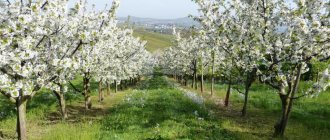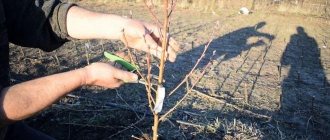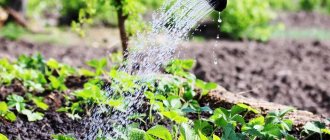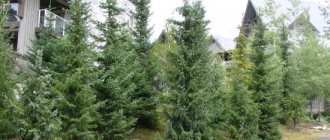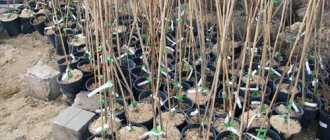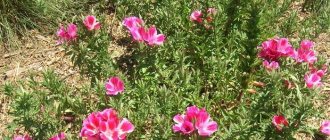The cost of good seedlings is not comparable to the mental and material expenses that arise in the event of death or poor growth of young plants.
Therefore, before planting trees with your own hands, it is important to learn a few rules regarding which seedlings to choose, when and how to plant pears, cherries and apples in your summer cottage.
Planting fruit trees in spring
How to choose fruit tree seedlings before planting?
To ensure that trees grow quickly, do not get sick, and bear fruit abundantly in the future, you need to buy seedlings from specialized retail outlets or nurseries. Zoned seedlings that were grown in the same area where they are going to be planted will take root much faster than their counterparts brought from coastal regions.
What to look for when choosing fruit tree seedlings for planting
Groundwater in a summer cottage
- for vigorous trees with long roots, the depth of groundwater in the area should not exceed 3 meters;
- semi-dwarf ones are planted in soil, the subsoil waters of which rise no higher than 2.5 m;
- seedlings of dwarf trees with a shallow root system require an area with groundwater located at a level above 1.5 meters.
Soil quality
Selecting a landing site at random is a mistake. The seedlings will develop poorly and will enter the fruiting season very late. If we talk about the preferences of fruit plants to soil conditions, then apple trees develop well on sod-podzolic, gray forest and chernozem soils of light composition with a neutral reaction. Pears love moist, slightly podzolized soils, sandy loams and loams. Cherries are medium to light loams.
Illumination
Good lighting is vital for fruit trees. The more sun a plant receives, the larger and sweeter its fruits will be. Based on this, seedlings are planted on the southern (less often southwestern) side of the site, in a place protected from the winds.
The area of the land
The area allocated for planting apple, pear and cherry trees is selected after calculating the sum of the heights of all trees. That is, if different crops with a height of 5 m, 4 m and 3 m grow in the garden, then they need to be planted at a distance of 6-9 m from each other. If you plant the seedlings more densely, they will not die from this, but also as they develop, they will grow not in breadth, but upward, intertwining branches, interfering, rubbing and shading each other.
Age of tree seedlings
The best option for planting would be a tree that is not yet 2 years old. How to determine the age of a seedling? The absence of branches on the trunk will help to identify such a seedling. Gardeners do not recommend purchasing plants with branches, dried out roots, or growths on the stem and leaves.
Grafted and rooted seedlings
Ask the seller what kind of seedling it is - grafted or self-rooted! Pear and apple trees must be grafted. Plums and cherries are much rarer.
How to distinguish whether a seedling is grafted or not? If the grafting was done with a bud, then the stem of the seedling will be slightly bent (another sign - look for a noticeable fine on the trunk). There are no signs of vaccination, which means they are trying to deceive you!
Fruit tree seedlings - sale in the nursery
The best option is to buy seedlings in a container or with a ball of earth that completely covers the root system. To ensure that the roots (the standard of tree quality) of freshly dug plants do not dry out, they are planted within a couple of days after purchase. Fruit trees in containers are planted at any time convenient for the summer resident - from late autumn to early spring.
Aesthetic garden
Are you not a fan of unusual fruit crops? Do you want to allocate more space for vegetables and flowers? This is also not a problem - they can be planted in the garden.
What vegetables can be planted under fruit trees?
Here we will immediately make a reservation: if you have huge trees with neglected crowns, it will be difficult to grow anything under them. If they are pruned according to all the rules, then there will be enough light there to plant a whole vegetable garden.
For example, you can plant cucumbers under apple trees and let them climb up the tree. Many, by the way, are sure that green plants need a lot of light, but experienced gardeners think differently. They even have a proverb: cucumbers love shade and hedges.
Parsley, cilantro, and many types of lettuce feel great in tree trunk circles. Some gardeners plant zucchini, pumpkins and beets in the garden. And they get good harvests!
Beans grow well in the garden, but not climbing beans, since they need a lot of sun, but bush beans.
Garlic is an ideal neighbor for trees and shrubs. While it is actively growing in the spring, its large fruit-bearing neighbors shelter it from birds, which love to pull seedlings out of the ground. He himself protects the trees from pests - they cannot stand the pungent smell. Wild garlic feels good in the garden.
Hyssop, mint and lemon balm have a protective effect. These aromatic herbs are quite shade-tolerant and get along well with trees. And they bloom very beautifully!
German gardeners believe that the best plant for tree trunks is nasturtium. It has very spectacular flowers, which are also edible - they are added to salads. In addition, nasturtium helps improve the soil in the garden - its roots attract earthworms, which perfectly loosen the soil. But that’s not all: aphids do not like the smell of this flower.
As you can see, the list of crops that can be planted in the garden is quite extensive. But when planting a vegetable garden under trees, you need to take into account 4 important conditions.
1. Plant vegetables not with seedlings, but with seeds. After all, when digging a hole for a young bush, such as a cucumber or zucchini, you can damage the roots of the tree. Any wound is an open “door” for disease. You can make a hole under the seeds with a stick, because they are sown shallow, so the risk is minimal.
2. It will be possible to combat pests of trees and shrubs only in early spring, until the vegetables are planted. Otherwise, all the poison will end up on your garden plants, and with them straight to your table. Especially with green crops - cilantro, parsley and salads. If an invasion of pests or diseases occurs in the summer, only safe preparations can be used. For example, decoctions and infusions of herbs.
3. Water more often. Vegetables, although they look small against the background of trees, are serious competitors to fruit plants! In a pumpkin, for example, the roots work like powerful pumps, taking all the moisture even from great depths. So, pour water, don’t be sorry.
4. Do not plant plants very often - there should be a place in the garden where an apple can fall.
What flowers can be grown under fruit trees
There is also quite a wide range here. But experts make a reservation: it is necessary to take into account the compatibility of flowers and fruit plants.
Under the apple tree grow beautifully: crocuses and muscari, daisies and daffodils, forget-me-nots and bluebells. In addition, the following plants feel good there: bathwort and lumbago, lungwort and pansies, primroses and balsams, as well as marigolds, daylilies and periwinkles.
Under the pear tree there is a place for daisies, primroses, Carpathian bells, phlox subulates, strawberries and marigolds.
Under the plum tree it is convenient for primrose and bulbous perennials.
Under walnuts , ferns, lilies of the valley, hosta, lemon balm, and daffodils are good.
You can plant celandine under trees - this is an excellent protection against aphids and ants! In addition, you will always have medicinal herbs at hand.
What else can you grow under fruit trees?
And, of course, the best place for mushrooms is under the trees!
The most unpretentious of them are winter mushrooms. They grow with pleasure under apple trees, and under plum trees, and under cherry trees. Propagating them is very simple: you need to collect old caps from the forest, crumble them into a bucket of water, leave for 2 hours and pour them under the trees. As a rule, they produce the first harvest the very next year.
Many people do not recommend growing autumn honey mushrooms in the garden. They say they are dangerous parasites. They will settle on tree trunks and eventually destroy them. However, our personal experience shows that they do not settle on fruit crops - they grow in the soil.
Champignons grow beautifully in the garden. But it is important for them that there is a lot of organic matter in the soil. Morels and chanterelles will take root here.
By the way, the mycelium of many mushrooms penetrates the roots of trees and forms a symbiosis with them. As a result, it is easier for fruit plants to obtain their own nutrients.
When should you plant a tree?
The timing of planting fruit trees is determined taking into account the biological characteristics of the variety and climatic conditions. Apple and pear trees are planted in two periods: in early autumn and early spring.
Planting trees in spring
Spring planting begins from the moment the last snow melts and ends ten days before the buds open. For planting apple, cherry and pear trees, a natural product – fresh manure – is used as fertilizer. It is poured to the bottom of the pit. When the seedlings have settled down a little (after about a week), growth activators are added to the soil.
Planting trees in autumn
The survival rate of fruit trees planted during the rainy season (the time of biological dormancy of plants) is almost 100%. Loose, moisture-saturated soil and relatively warm air temperatures contribute to the stable survival of fruit seedlings. It is interesting that when planting plants in the fall before the onset of frost, the seedlings have time to produce young roots before going into hibernation and stopping growing. A layer of organic matter and mulch will protect the roots in a snowless winter. Material prepared for the website www.moydomik.net
Planting trees in winter
Winter plantings are relevant when it comes to large-sized plants. Young fruit tree seedlings should not be planted in frozen soil.
Planting trees in summer
During the hot period, extensive evaporation occurs through the leaves. Short roots lack moisture and do not grow. Seedlings planted in summer are doomed to death.
What plants can be planted nearby?
This is perhaps one of the most important points that should be clarified before planting seedlings. Plant compatibility is called allelopathy. It can be both negative and positive.
The best compatibility of fruit trees will be achieved if plants of the same type are planted nearby: apple trees with apple trees, pears with pears, cherries with cherries. But such a garden of the same type will look quite boring. And therefore, in our gardens there are trees of different types, which are important to plant correctly. For example, a pear will feel great next to an apple tree and red rowan, while a cherry or peach will cause it a lot of inconvenience.
In the case of positive allelopathy, trees in the garden can not only exist safely in the neighborhood, but also be mutually beneficial. Therefore, before planning planting in the garden, it is recommended to check the compatibility table of various crops.
The walnut gets along the worst with its “neighbors” in the garden. This tree is considered toxic and can inhibit almost all fruit crops. Therefore, if you are going to have such a plant in your garden, find a place for it on the outskirts of the site, where it will not disturb anyone.
How to properly plant trees on a site?
Step-by-step instructions for planting seedlings yourself - recommendations for beginners
Soil preparation
Planting a future orchard begins with preparing the soil. The area is cleared of weeds mechanically or using herbicides. Pre-planting cultivation is carried out - deep plowing and filling the soil with mineral and organic fertilizers.
Preparing holes for planting trees
If you plan to plant fruit trees in the spring, then the soil and pits begin to be prepared in the fall. To do this, a square hole 50-70 cm deep, with sides from 1 to 1.5 m, is dug under each seedling. Cut branches, old leaves, compost, tops, etc. are placed in the pit. The top is covered with soil and left to rot until spring planting.
For autumn planting, the pits are prepared a month in advance. Crushed stone, a layer of broken brick and coarse river sand are placed at the bottom for good drainage. Then the planting hole is filled with rotted manure, peat and complex mineral fertilizers using the layer-by-layer method. The top of the fertilizer is covered with soil mixed with humus, 5-10 cm thick.
The soil is poured into the pit in the shape of a cone.
It is strictly forbidden to smooth the walls of the pit with a shovel - loose, compacted soil impedes air exchange and limits the growth of new roots.
Planting seedlings in prepared soil
After the soil has settled, a stable wooden stake is driven into the center of the hole. Reliable support will prevent the wind from rocking the young plant and will prevent the formation of voids between the soil and roots.
The day before planting, remove broken branches and roots from the seedlings and renew them, lightly trimming them to healthy tissue with pruning shears.
Planting trees - rule No. 1
The root collar of the seedling should be above the soil level. Significant penetration of the plant trunk into the soil leads to rotting of the bark and further death.
It is quite easy to determine the root collar on the trunk - this is the border between the transition of the tree bark from greenish to milky brown.
Root collar of a seedling - diagram
Root collar of a seedling - view on a tree
When planting, the top of the earthen cone should rest against the base of the trunk. The roots are carefully spread along the slope and covered with soil, focusing on the root collar. It should be 5-6 cm higher above the ground surface.
When filling the tree with black soil, shake it a little so that the voids between the roots are filled with soil. Otherwise, they may dry out.
Near the trunk, the soil is lightly compacted with a foot and watered with a weak stream of water at the rate of 3 buckets per tree. Wait until the soil settles a little. Water again and compact well.
After watering, the roots may stick out a little from the ground. They will go into the ground in a few days.
Exposed root system should be kept moist
Root pruning
How to plant a tree correctly
Planting a tree from a container
Planting a seedling from a container
Planting a tree seedling from a container
Planting a seedling with a ball of earth
Planting a tree with a ball of earth
Planting a tree - water and fill with soil
What to do if you didn’t have time to plant in the fall?
It happens that it is not possible to buy the right, interesting variety on time, or garden material ordered by postal delivery arrives too late, when the last deadline for autumn planting has already passed. Or, as is the case with stone fruits, which in the central region are planted only in the spring, and seedlings are purchased in the fall. The question arises, how to preserve them?
Storage by digging
Experienced gardeners leave seedlings directly on the site using the digging method. As a rule, they choose a bed free of vegetables in a flat, dry part of the garden and dig a trench in the west-east direction. Its depth is 50 cm, width – 30 cm.
Plants are prepared for planting: leaves are removed, damaged roots are trimmed, and the root system is immersed in a bucket of water for several hours. The seedlings are placed in a prepared trench with their roots to the north and branches to the south. The roots are sprinkled with a 30 cm layer of soil and watered generously. And just before frost, they dig in almost completely, leaving only the tops. A layer of sawdust, leaves, and pine needles is poured on top. In winter, snow is thrown over the pit.
We invite you to watch a video demonstrating the digging method:
In the spring, when the soil begins to thaw, the overwintered trees are carefully dug up, piece by piece, and planted in a permanent place in planting holes prepared in advance, preferably in the fall.
The cellar will help out
If the house has a cellar or a cool basement, underground, you can save planting material there too. The root system is moistened. The plant is placed in a container (buckets, pots, boxes) with moist soil (soil mixture, sawdust, peat).
Instead of solid containers, it is convenient to use thick plastic bags with several holes for aeration
A tree exposed to light after storage may get sunburned. Preliminary adaptation is necessary: the seedlings are placed in partial shade for several days, then planted.
In addition to the planting date, successful survival is influenced by a number of factors: the choice of location on the site, the type and fertility of the soil, the variety, the condition of the seedling, proper planting and subsequent agrotechnical methods for cultivating a particular crop.
Caring for trees after planting
In the first two years of life, young trees require a lot of attention. Moderate regular watering and fertilizing, loosening and weed control are important. In dry times, the soil must be thoroughly loosened after each watering or rare rain.
Mulching around tree trunks cannot be ignored. Rotting mulch (cut grass from cereals) performs several useful functions at once:
- provides good aeration of the root system;
- protects the soil from drying out;
- prevents weeds from germinating;
- protects against soil freezing in winter;
- provides seedlings with organic nutrients;
- prevents the appearance of soil crust.
Excessively moist soils should not be mulched.
After planting, trees are mulched
For the winter, trees are insulated by tying the trunk with burlap or pine branches.
The first pruning of young trees is carried out in the second year of life.
Planting shrubs in autumn
Most often, autumn planting of shrubs is practiced in the central zone of our country, including the Moscow region. At this time, you can plant the following berry bushes: white, red and black currants, chokeberries, gooseberries, raspberries, honeysuckle, sea buckthorn.
As a rule, autumn planting begins in mid-September, when the life processes of the plant slow down.
Landing dates
In central Russia, autumn planting of shrubs takes place from mid-September to almost the end of October. In the northern regions, planting dates end in early October, and in the southern regions, on the contrary, the planting dates are extended until the second ten days of November.
Figure 8. Compatibility of fruit trees and shrubs
However, the main indicator of the most optimal time for autumn planting is the onset of the plant's dormant period. It can be determined by the end of leaf fall. It is important to know that seedlings dug up before the beginning of the period of biological dormancy freeze in winter, primarily due to immature shoots.
Planting fruit tree seedlings with your own hands - tips
Useful recommendations for gardeners:
How to plant an apple tree?
Early-fruiting varieties of some apple trees can bloom in the first spring. But they are not yet developed enough to form a full-fledged harvest in the fall. Therefore, for good survival, the buds are cut off before they bloom. In the second year (provided that the plant develops without problems), a couple of dozen flowers are left on the tree.
Among the most easily adaptable varieties of apple trees are: “Grushovka Moskovskaya”, “Antonovka ordinary”, “Summer striped”, “Brusnichnoe”, “Dessert Isaeva”, “Gift to Grafsky”, “Cinnamon new”. Good varieties: “China Kerr”, “Arkadik”, “Ovalnoe”, “Lungwort” and “Candy”.
How to plant a pear?
Most types of pears known to summer residents do not have special requirements for exposure and soil composition. But pear trees take root and grow better in humus-rich, loose soils and well-lit areas. Young plants do not tolerate drought. In the first years they need to be watered abundantly and often. Pears begin to bear fruit at the age of 3-8 years.
As a result of hybridization of species, specialists in the field of breeding have developed a huge number of interesting varieties. Among the popular ones: “Pear Favorite Klappa”, “Pear Lada”, “Pear Nectar”, “Cathedral”, “Allegro”, “Dibrovskaya”, “Beauty Chernenko”.
How to plant cherries?
The fruiting of cherries largely depends on the planting location on the site. Wrong choice leads to poor growth and poor yields. The cherry root system, located close to the surface, is sensitive to drought. Therefore, loosening after watering is done extremely carefully.
In the gardens of our country, local, winter-hardy varieties predominate: “Octava”, “Bagryannaya”, “Kentskaya”, “Shubinka”, “Rossoshanskaya Chernaya”, “Rusinka”, “Polevka”, “Molodezhnaya”, “Malinovka”, “Prima” , “Turgenevka”, “Lyubskaya”, “Zhukovskaya”, “Generous”.
Planting a tree with your own hands - video
Benefits of autumn planting
The timing is different, but the “start” of autumn planting gives rise to massive leaf fall. The main thing is to do it 2-3 weeks before the onset of stable frosts.
There are a number of advantageous aspects to carrying out planting work in the fall:
- Nurseries and private gardeners offer a wide selection of planting material. A clear demonstration of the fruit is an undoubted advantage!
- Good survival rate. The root system of the plant continues to grow and develop even at a temperature of +3 ℃. It has been proven that overwintered seedlings are stronger and more resilient than those planted in the spring. Wintering develops their immunity to return frosts and temperature changes.
- Easy care. For autumn seedlings, only one watering is required immediately after planting; further moisture will be provided by rains.
- In autumn, pests go into suspended animation (hibernation) and can no longer harm young trees.
- After completing the main work on the site, the gardener has free time, which can be used to replenish his own fruit and berry collection.
After a safe winter, the seedlings immediately begin to grow and begin active vegetation faster
Planting cherries and sweet cherries
The distance between plants is 1.5-2 m. The root collar is 3-5 cm above ground level. Soil mixture: leaf or garden soil, sand (3:1). 10-15 kg of organic fertilizers are added to the planting hole, 150-300 g phosphorus, 40-80 g potassium or 500 g ash. Liming is carried out on acidic soils. Nitrogen fertilizers are applied in the spring, phosphorus and potassium fertilizers in the fall. Organic fertilizers can be applied in autumn and spring (8-10 kg per 1 sq.m.).
During dry periods, young plants are watered frequently and abundantly. In the fall, the soil is dug to a depth of 15-20 cm. During the season, the soil is loosened 3-4 times. The best place for cherries is open sunny spaces with good aeration. For cherries, choose the warmest, most elevated areas and protected from cold winds.
Mini trees in pots in the garden
To plant plants in pots, you need to choose shade-loving trees that can develop regardless of environmental conditions. It is advisable to adhere to the following rules:
- the pot should easily accommodate the root;
- at the bottom of the container you need to make several holes to remove excess moisture;
- it is preferable to choose a wooden version of the material for the container so that the soil does not stagnate;
- It is better to choose the south side of the site for placement.
Trees in pots
Note! In some situations, open ground is better than a pot, since many varieties have an overly branched root system.
Watering and care
Immediately after planting, it is necessary to water the roots of the plant. This should be done using a watering can or hose with a nozzle that stops the strong water pressure. After this, it is recommended to wait until the water in the watering basin is absorbed into the soil and water the plant again.
In the first year after planting, it is necessary to water regularly depending on the drying of the soil. If there is a period of drought, you will have to water almost every day. Over time, the frequency of watering should be moderately reduced. After 3 years of planting, this procedure can be completely stopped.
During the first two years of a tree’s life, it is necessary to carefully monitor its development and correct any deficiencies that arise. During the first year after planting, the seedling does not need feeding, since all the necessary fertilizers were obtained during the process of immersion in the ground.
Planting a tree correctly is not that easy. However, if you follow all the prescribed recommendations and approach the process responsibly, then no problems should arise.
Types of large sizes
Large-sized trees include all trees and shrubs that are more than 2 meters tall, as well as a well-developed root system and crown.
To create landscape compositions, three types of ornamental and fruit trees are used:
- fruit (cherries, apples, apricots, pears);
- conifers (spruce, pine, fir, thuja);
- deciduous (oaks, poplars, birches, maples, chestnuts).
Also, currently, sakura is popular in Russia. It will fit organically into a Japanese-style garden.
Planting raspberries and blackberries
Planted in a sunny place protected from the wind. Raspberries do not tolerate close groundwater and soil salinity. The distance between bushes is at least 0.7 m. The root collar is at ground level. The soil is a mixture of peat and turf soil (1:1). 4-5 kg of humus or compost, 100 g of superphosphate and 50 g of potassium sulfate are added to the planting hole. Optimal soil acidity pH 5.8-6.7 On acidic soils, add lime at the rate of 200-400 g per 1 sq.m.
The use of supports is required. Fertilize with urea annually (3 times a season). 1st - in May, 2nd - two weeks later, 3rd - two weeks after the second (5 mg/l). After 2-3 years, phosphate fertilizers (superphosphate -30 mg/l) and potassium fertilizers (potassium sulfate - 15 mg/l) are applied. Organic fertilizers are applied in the fall when digging up plants. When planting, water 1 bucket per plant, then as needed. After planting, mulch with peat, humus, leaves, bark, pine needles or black plastic film.
How can you grow a tree from a seed?
Good ripe seeds should be washed and soaked in a special solution - a growth stimulator for 3 days. With the onset of autumn, the seeds are planted immediately. For planting in spring, seeds should first be stored in the freezer for stratification.
It should be taken into account that those trees that were planted from seeds on their own grow quite tall. Since, unlike cultivated fruit species, which are sold by almost all nurseries, they are not initially grafted onto a dwarf rootstock.

